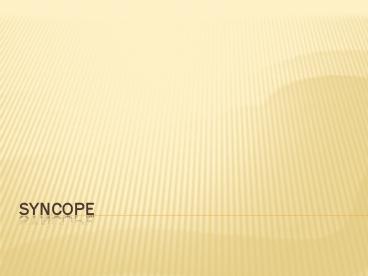Syncope - PowerPoint PPT Presentation
1 / 27
Title:
Syncope
Description:
Syncope is a common disorder, affecting 30% of adults Syncope is responsible 1% to 6% of emergency department visits 0.6% to 1.0% of hospital admissions Bimodal ... – PowerPoint PPT presentation
Number of Views:58
Avg rating:3.0/5.0
Title: Syncope
1
Syncope
2
- Syncope is a common disorder,
- affecting 30 of adults
- Syncope is responsible
- 1 to 6 of emergency department visits
- 0.6 to 1.0 of hospital admissions
- Bimodal presentation
- Peak at early adulthood
- Neurocardiogenic
- Late in life
- degenerative
3
- Difficulty in diagnoses
- Episodes may be sporadic
- Multiple possible causes
4
(No Transcript)
5
(No Transcript)
6
Neurocardiogenic syncope
- Normal reflex
- Venous pooling
- Drop in BP
- Increased symp drive
- Myocardial C fibres also affect vagal tone
7
Neurocardiogenic syncope
- Abnormal reflex
- Increased venous pooling
- Increased symp drive
- Marked pressure effect on C fibres
- Paradoxical increase in vagal tone
- Reduces contraction
- Increases dilatation
8
Diagnostic tests and yields
- ECG 2-11
- Holter Monitoring 2
- External Loop Recorder 20
- Tilt Table 11-87
- EP Study without structural heart disease11
- EP Study with structural heart disease 49
- Neurological (CT scan, carotid doppler) 0-4
9
(No Transcript)
10
Diagnostic tests and yields
- ECG 2-11
- Holter Monitoring 2
- External Loop Recorder 20
- Tilt Table 11-87
- EP Study without structural heart disease11
- EP Study with structural heart disease 49
- Neurological (CT scan, carotid doppler) 0-4
- Implantable loop recorder 43-88
11
Syncope increases mortality
- Study of survival rates with and without syncope
- Cardiac syncope carried a 6-month mortality rate
of greater than 10 - Cardiac syncope doubled the risk of death
12
Case 1
- 64yo male
- Suddenly felt unwell, strange, dizzy LOC for 2
minutes - ECG, Echo, 48hr Holter, Tilt, MRI and sleep
deprived EEG all NAD - Loop recorder inserted
- Similar episode
- 25s pause
- DDD PM inserted
13
Case 1
- He collapsed again several weeks later, while
sitting for a meal at a wedding. - Repeat EEG
- Temporal-lobe epilepsy was diagnosed,
- Treated with oxcarbazepine.
- He remains asymptomatic at 1 year of follow-up.
14
Case 1
- Ictal bradycardia is a rare manifestation of
epileptic seizures. - There is limited evidence of a preferential left
temporal-lobe onset. - Most patients are male and gt60 years of age
- This pattern of epilepsy may induce central or
obstructive apneas as well as SCD - Temporal-lobe epilepsy may present with feelings
of panic and impending doom, palpitations,
diaphoresis, dyspnea, and paresthesias. - Hence, it is easily misdiagnosed as an anxiety
attack. - The discovery of a major arrhythmia without EEG
monitoring may lead to an incorrect diagnosis - Cardiac pacemakers may be indicated in
symptomatic ictal bradycardia or asymptomatic
bradycardia lasting more than 5 seconds.
15
CASE 2
- 73yo male
- Under care of diabetic service
- Referred to cardiology for work-up of black-outs
- ECG, Echo, 24hr and 7 day holter normal
- Loop recorder implanted
16
Case 2
- After 6 months
- will you check this mans Loop
Recorder.........Neurologist reckons he had a 52
second pause on an EEG - Id say its a typo!....meant 5.2 seconds
- Loop recorder revealed no patient activated
episodes - Automatic episodes all later than date of EEG
17
Case 2
18
Case 2
19
Case 2
20
Case 2
21
Case 2
22
Case 3
- 22yo female
- Referred to Cardiology from Neurology for
implantation of loop recorder due to syncope - No significant medical Hx
- Admitted to previous ectasy use, smokes cannabis
every day - ECG, 7day Holter, Echo NAD
- MRI, CT, Sleep deprived EEG NAD
- Loop recorder inserted
23
Case 3
- Presented following syncopal episode
- No awareness of onset
- When full awareness regained sitting up in
chair - Speaks gibberish for minutes prior to episode
- Interrogation revealed
24
Case 3
4.2 second pause
25
Case 3
26
Case 3
- Also had one episode of speaking gibberish for
five minutes, no syncope - No associated arrhythmia
27
Case 3
- Questions
- Would you pace this patient now
- What is the sensitivity/specificity of an EEG in
this setting - What is the usefulness of repeat EEG































